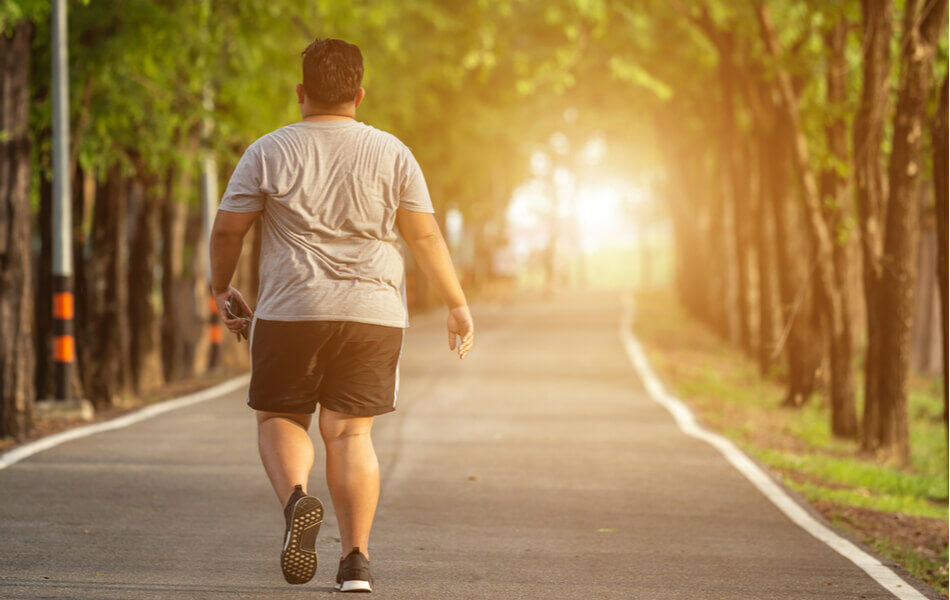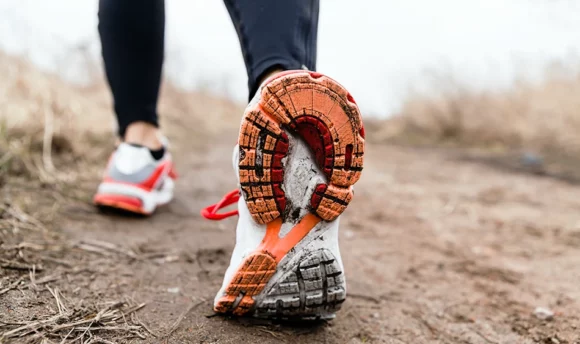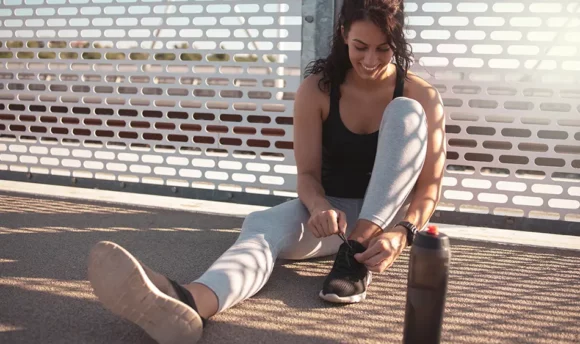Running When Overweight: 7 Tips How to Lose Unnecessary Fats
Everything you need to know about running so you can start shedding pounds and actually keep them off.

Runners come in all shapes and sizes. It’s time to stop comparing yourself to fitness models and thinking, “I’ll never look like that.” The truth is, everyone’s fitness journey is going to look different. Regardless of where you might be starting, you have the power to change your habits, lose weight, and change your life.
That being said, there are certain challenges you will face when you start running if you’re overweight. Being aware of the challenges and having tools ready to deal with them will help make your fitness journey successful.
In this article, you will learn some tips on how to start running when overweight, as well as other tools to help you on your weight loss journey.
Reasons Why You Should Start Running
Running has so many amazing benefits for not only the body but the mind as well. Here are three of our favorite reasons why you should start running to help inspire you to start.
Reduces risks of cardiovascular diseases
Cardiovascular disease is the leading cause of death in America, according to the Centers for Disease Control and Prevention. Cardiovascular diseases are anything that affects the heart and arteries, like heart attacks and strokes. Lowering your chances of being affected by diseases like this should be at the top of everyone’s priority list.
Luckily, there are studies that show that any amount of running can lower your risk of death from cardiovascular disease by 27%.
Strengthens your bones and muscles
It’s common knowledge that running can help build your muscles, but it can also help strengthen your bones.
Running increases the size and capacity of your muscles by creating small tears in the tissues as you run. This breakdown of the muscles is what causes soreness after your workouts. When your body has the chance to rest, it repairs these small muscle tears, increasing your muscles’ strength and size.
High-impact exercise like running can also help strengthen your bones. This is because the motion of pushing your weight against the ground helps increase blood flow in the muscle around your bones, which allows new bone tissue to form.
Improves cognitive performance
It’s called a “runner’s high” for a good reason. After running, you might notice that you feel less stress in your body, and your brain feels more alert. This is because running increases the blood flow to the prefrontal cortex of the brain – the part responsible for your thought-processing and mood regulation.
Running increases blood flow to your brain and prompts your mind to be more alert as it works to control your body’s fast movements. Studies show that as little as 10 minutes of vigorous activity such as running can greatly improve overall health.
Dangers of Running Overweight
Chafing
Chafing is a common problem that can happen to anyone when running but can be exacerbated by being overweight. Extra weight and loose skin can lead to chafing. This often happens on your inner thighs or upper arms and is caused by skin-on-skin friction.
Be mindful to prevent chafing as you run by wearing proper moisture-wicking clothing that doesn’t rub against your skin as you run. Also, make sure to properly treat damaged skin to prevent things like bacterial infections.
Risk of joint injuries
High-impact sports like running can have a damaging effect on your joints if not done correctly.
Running long distances at a fast pace should be something you work up to. Overweight runners will struggle with the pressure of impact on their knees as they run. This is because it can put a strain on the ligaments that are not yet used to this kind of intense exercise.
Heart attack
Although running can have positive effects on your cardiovascular system, the initial strain of vigorous activity can be intense for your body.
Running when you are overweight puts extra strain on your heart. As you run, your blood flow increases, as does your blood pressure. When your heart and arteries aren’t used to having this sort of pressure, working to provide blood to the rest of your body can strain your vascular system.
7 Tips for Overweight Runners
Whether it’s buying proper gear or creating a fitness program that is right for you, the following tips will help prepare you for your running journey.
#1 Consult with your doctor
The risks of heart attacks and other serious injuries greatly increase when you are overweight. This is why it is important for anyone, but especially those who are already overweight, to check with their doctors before engaging in an intense cardio activity.
Your doctor can do an exercise stress test with you or monitor your heart through an ECG to check on your heart health. Having regular checkups can help you stay safe while you work your body back into health.
#2 Choose a comfortable running gear
Investing in running shoes that feel really good is one of the best things you can do to help you reach your fitness goals.
Chances are, as you run, you are going to be feeling a lot of discomfort in your body, especially in the beginning. You don’t want to be focused on how uncomfortable your feet feel in your shoes or how suffocated you feel in your workout clothes.
Wearing breathable clothing that fits you well and makes you feel confident can help you enjoy your workouts more. Not having to be worried about your shorts riding up, uncomfortable chafing from ill-fitting clothing or a lack of support in your undergarments is worth the initial investment in proper workout gear.
#3 Stretch before and after the run
By stretching before you run, you decrease your chances of injuring yourself by pulling a muscle. Start with a light jog as a warm-up, and then stop to do a few minutes of light stretching before your run. This will also help you tune into your body before you begin exercising.
Stretching after you run can give your body the chance to gradually lower your heart rate back to normal. It can also help improve blood flow to all of your muscles, which will reduce lactic acid buildup, reducing your soreness the next day.
In general, stretching is an important part of any workout routine because it allows your muscles to stay loose and limber, which helps prevent tightness and injury.
#4 Start with walking
If it has been a while since you exercised, throwing yourself into long runs might not be the best decision for you.
Walking has a lot of the same benefits as running – such as weight loss, improving your cardiovascular health, and reducing stress – and is a good stepping stone to more rigorous exercises.
Going for regular walks can help you get in the habit of getting outside. Building these routines can often be the hardest part of making lifestyle changes.
#5 Continue with low-intensity runs
Going for a run doesn’t mean finishing a marathon. There is no rulebook that says how far you have to go or how quickly you have to get there.
When you begin running, you might want to start out with low-intensity runs. Low-intensity runs are anything that gets you to about 50% of your maximum heart rate. This rate shouldn’t feel completely comfortable but also be something that you can maintain for a good amount of time. Once you’ve reached this level of output, you will continue running at this pace for at least 30 minutes.
The great thing about running at this pace is that it doesn’t put your body under a lot of unnecessary strain. This means you will be able to be more consistent with your workouts without having to take long stints off due to soreness or injury.
#6 Don’t overpush yourself
If you’re anything like me – or most of the world – you might be tempted to make a big overhaul to your current fitness habits.
Deciding that you want to wake up at 5 AM every morning to go for a run might sound like a great idea, but in reality, it’s not sustainable.
Chances are, going from almost never working out to running multiple miles every morning isn’t something you will be able to sustain over the long term. And your inability to stay consistent could be enough to make you fall off track completely.
When you start running, it’s great to start off small. Begin by doing low-intensity exercises a couple of times a week. Try adding in a few short walks before or after work to begin setting yourself up with healthier habits.
Keep in mind that the beginning is always the hardest, and that the more consistent you are, the easier it will get.
#7 Prepare the running plan and strategy
Being unsure of how to start running when overweight shouldn’t stop you from starting your running journey. Having a strategy for any new endeavor will help you be successful in it, and running is no different.
Instead of buying a new pair of running shoes and hoping for the best, invest time and energy into creating a personalized running program for yourself. This can be the deciding factor in whether or not you end up reaching your fitness goals.
If you’re not sure where to start, there are training apps that can create personalized running programs for you.
Other Tips That Can Help With Weight Loss
Knowledge is power. Here are a few extra tools and insights that can help you create lasting changes in your life.
Try different types of diets
It’s said that abs are made in the kitchen, and for a good reason. Following a healthy diet is an important part of weight loss. Although exercise is a big part of losing weight and living a healthier life, without a proper diet, working out will only get you so far.
There are many different diets you can choose from:
Ketogenic/low-carb: A ketogenic diet is where you eat only foods that are high in fat and completely cut out carbohydrates and sugar. This is done to help get your body into a state of ketosis, which puts your body in a fat-burning mode. This helps reduce fat stored in the body.
Paleo: A paleo diet focuses on eating the foods of our ancestors, mostly meat and vegetables. Cutting out sugar, dairy, and carbs helps reduce your calorie intake and lose weight.
Vegan: A vegan diet eliminates all animal products, including meat, cheese, and eggs, to focus on consuming more plant-based foods. Fruits and vegetables are foods that are low in calories and more easily processed by the body. This can aid in weight loss.
The important thing to remember with dieting is that you have to find something that is sustainable. Being restrictive with your eating might help you lose weight quickly, but you could end up returning to your old habits and gaining it back.
This process should be about creating new, healthier habits that can help you sustain a healthy lifestyle for years to come. Focus on eating what feels good in the body rather than just losing weight.
Low-intensity workouts
Low-intensity workouts are a great place for any beginner to start. They are not overly strenuous on the body but will help you build increased lean muscle mass. Getting into a routine of doing low-intensity workouts can help you get into the habit of regular exercise. When you feel ready, you can begin to increase the intensity.
Some examples of low-intensity workouts are:
Strength training: If you want to start building muscle and get your body ready for more intense workouts, you can start with light strength-training exercises. Lifting light weights for high reps can help you build muscle strength.
Swimming: Swimming is the perfect low-impact exercise for anyone who is currently overweight. Moving through the water creates resistance for your muscles and helps burn calories, and the water can help release the tension on the joints.
Walking: Although it might not seem like it, walking is actually a great way to burn calories and gain muscle.
Yoga: A moderately paced hatha or vinyasa class will help you begin to strengthen your body and release stress. Start by attending an in-person class until you’ve figured out the proper form, and afterward, you can consider doing classes from home.
Avoid high-calorie drinks
Even if you are intentional about what you eat, drinking high-calorie drinks can keep you from losing weight.
Soda, alcohol, and even “health” drinks like Vitamin Water are full of added sugars. When we ingest more sugar than our body can process, it ends up getting stored in the body as fat.
Next time you are at the store, look at how many calories are in your beverage of choice, and consider making the switch to a healthier option.
A Word From Our Coach
Making big changes in your life is never going to be easy or feel comfortable. Whether you want to lose that extra weight, reduce stress, or just improve your overall health and happiness, good habits are the way to get there.
If you are just starting out on your fitness journey, it might be helpful for you to come up with a mantra. Something simple you can repeat to yourself on those days you feel tempted to quit. Never lose sight of the reasons you want to make a change, and continue showing up for yourself.
Bottom Line
Running overweight comes with certain setbacks, but nothing that can’t be overcome with some patience and planning. Regardless of where you’re starting out, there’s always room for improvement, and there’s no rush to cross the finish line.
Prepare yourself with a workout plan that works for you, along with proper gear and a positive mindset. You will be sure to lose weight and succeed in changing your life for the best.

















































 Select your language:
Select your language: 








